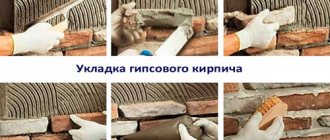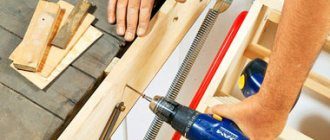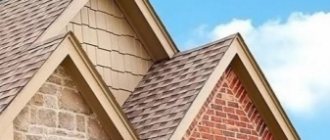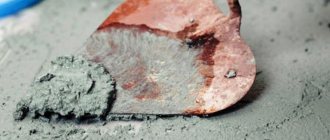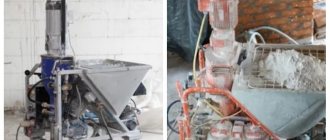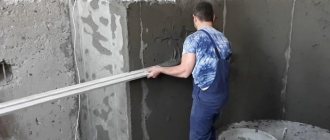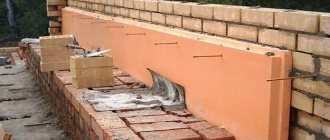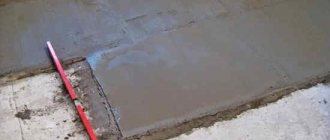The work of a builder has never been easy, and finishing work has always been one of the most labor-intensive. But mechanization has also reached this sector of construction, thanks to the appearance of a plastering machine - there is no longer a need to perform a number of rather difficult operations with your own hands. Plus, a plastering machine can replace an entire team of finishers, which is very beneficial from an economic point of view.
Plastering using a machine.
- Plastering station
What are these machines good for?
Machine application of plaster
A person must still be present nearby, because these installations do not belong to the group of autonomous robots.
But the most routine and complex processes are performed by the unit itself.
If we talk about physical activity, it is difficult to prepare solutions. The machine can cook everything itself.
The fact that water and dry mixtures have clearly dosed proportions becomes important, but the unit allows you to constantly obtain high-quality mixtures.
The complete elimination of the human factor is guaranteed, and when carrying out such work this is important.
The components are mixed using mechanical movements. The supply of the composition is carried out at high speed. Air is included in the solution. This saves money - the mixture takes up more volume with less spending. Compared to manual work, this solution is much more profitable.
The machine is capable of doing the same job as a whole team of workers, only much faster, and the solution is quickly and evenly applied to the walls and also takes less time to dry.
All this helps to improve the overall quality of the finish.
- The controls of such a machine are accessible and understandable to users of any level of training. Any buyer will understand the operating instructions without additional help. The same goes for maintenance and repairs, if necessary.
- The units are made with small dimensions. For transportation, the structure is equipped with handles and wheels.
- Models are most often assembled from separate modules. The machine can be quickly disassembled and reassembled at any time. A relevant property for those who are interested in long-distance transportation and storage.
- If the unit is serial, then all basic work processes are regulated in it. Thanks to this, the machines can be used not only on large, but also on small construction sites, with small teams of workers.
Tools and materials required for manufacturing
The productivity of the average amateur is such a small figure that even a machine made from improvised means can significantly speed up the pace of work. Therefore, folk ingenuity and ingenuity make it possible to make a handicraft device from various components that are at hand.
A plastering station, made with your own hands for work, must basically contain several functional parts. The main components of which it consists:
container in which the solution is mixed (mixing chamber);
solution pump supplying the finished mixture;
receiving vessel for placing dry composition;
drive, which is used to supply the mortar hose;
mortar hose that supplies plaster to the sprayer.
To manufacture such a unit, a variety of devices, parts and mechanisms are used, for which only the imagination is enough.
DIY plaster station
The homemade device is inferior in performance to its factory counterparts, but it speeds up the application of plaster.
The mixture is applied without loss. This cannot be done manually. For non-professionals, the speed and power of the unit, which operates on manual pumping from the mains, is enough. All stages occur under human control; complex and routine work is performed by a machine. The plastering station model consists of individual parts. Easy to assemble and disassemble.
Note! When using the device, two people perform the same volume as a team working manually.
Main functional parts:
When assembling the device, spare parts from other mechanisms are used. You just need to show your imagination.
Plastering process
What are the features of the technology?
For uninterrupted operation, the device requires constant access to the electrical network. The presence of running water is also an important requirement, but only in some situations.
But don’t be upset if there is no device on the sites that can take water from other places. Many models are equipped with a pump that pumps liquid from any container.
The machines have bunker parts where the mixtures are supplied in dry form. Filling of ready-made mixtures, which are produced in factories, is also acceptable.
The solution must get inside special chambers; for this, a screw method is used. There it is mixed with water. The process is organized continuously.
The mortar hose, its end, is held in place by a special device. It usually looks like a pistol. This allows the mixture to be applied to the walls in an even and uniform layer.
The material is applied to the surface using several modes supported by plaster guns. The consistency of the solution and the type of surface being treated are determined by changes in technology.
Plastering machines operate on several types of pumps:
- Diaphragm
- Screw
- Piston
The design necessarily includes a cyclic block. Thanks to this, mixing occurs continuously.
Conventional plastering units have a simpler design.
Main types of devices
To carry out automatic plastering, you will need a wall plastering machine. If we are talking about a large facility with a significant area, then it makes sense to purchase this equipment. For short-term or one-time use, such a purchase is unprofitable, so it is better to rent equipment.
Avito Real Estate Kondopoga rent an apartment
Automatic pneumatic pistol
At the top of the machine there is a container for the mixture, usually five liters. The device is also equipped with a trigger that controls the supply of plaster. A hose for supplying compressed air is inserted into the lower part of the gun, into a specially provided hole.
Pneumatic shovel for mechanical method
Such an apparatus for applying plaster can be equipped with nozzles of different diameters, depending on the type of solution used. The machine itself is a metal container for a diluted solution. It is equipped with 4 nozzles for air supply and the same number of devices for material. Direct delivery to the surface is carried out through a special tube, which is coated with elastomer or other non-slip material to make the tool easier to hold with your hands. The tube is also equipped with a valve that regulates the supply of air under pressure.
Wall and ceiling pneumatic plaster shovel
Working with such a device is quite simple: you just need to point the tube at the surface to be treated and move it from side to side, while simultaneously pressing the solution supply button. Average productivity is 60 square meters per hour. Different models of this equipment are used to process walls and ceilings. They differ in the location of the container relative to the supply tube.
Installation of pneumatic hammer: machine for applying plaster using a mechanized method
A pneumatic hammer or pneumatic shovel is equipped with several nozzles that are designed for hard and soft solutions. The device consists of:
Plastering machines
The modern construction market offers a huge number of different models of small machines and large machines that are used for mixing and applying plasters. They differ in size, performance, equipment and, accordingly, cost. The market leaders are considered to be devices manufactured in German factories. The main feature of this technique is the possibility of not only plastering, but also painting.
As for domestically produced cars, they are easy to recognize by their significant size. With their help, you can apply starting leveling layers of plaster and putty. The plastering machine can be used for processing walls, ceilings and arranging self-leveling floors.
In most cases, a middle-class plastering machine is compact in size. One person is usually enough to operate it. This equipment is equipped with a pump, which is the main working body. It is used to mix, feed and spray the material onto the work surface. This type of plaster application machine is designed for materials with a grain size of no more than 2 mm.
Some units are equipped with separate containers for water and dry composition, as well as for mixing. The solution manufacturing process is fully automated and is carried out according to a preset program. This ensures the high quality of the resulting solution, its compliance with the required proportions and the absence of lumps and air bubbles.
Modern plastering machines are compact in size
What kind of compressor should be for the device?
The compressor for the station must be good and pump air quickly. Its main task is to create and maintain an operating mode at a pressure of two to three atmospheres.
About cars made with your own hands
How to make a plastering machine yourself
Of course, in mass production it is easy to find high-quality and practical, powerful tools.
But the price will be the main disadvantage for many.
When performing a one-time job, not everyone will decide to purchase expensive equipment.
And rent is not always available to buyers.
But even in such situations there is a way out - homemade plastering machines.
They will be inferior to serial models in power and performance, but have an acceptable cost.
And working with such a tool will not cause much trouble.
- As a basis for creating a tool such as a do-it-yourself plastering machine, we take an ordinary fire extinguisher with a capacity of up to 4 liters. It has most of the parts we need. These include pens and cylinders where solutions are placed. And a lever that opens the valve at the outlet.
- If the volume is larger, the product will become too bulky. And a small container will need to be refilled too often.
It all starts with cutting off the bottom of the fire extinguisher. A homemade machine works the same way as a spray gun. In this case, the fire extinguisher capacity plays the role of a solution hopper; its bottom should be at the top.
Next, the hole is drilled. It is located opposite the valve outlet. A metal tube is placed inside.
And then at its end a nozzle with a diameter of 4-5 millimeters is installed. Air is supplied through it, which is taken from the compressor.
The power of the device is determined by several factors:
- The gap between the parts of the incoming nozzle, as well as the nozzle
- What diameter is the outlet hole provided?
- Air pressure
The mixture is ejected more actively as the outlet nozzle approaches the nozzle.
15-20 millimeters from the nozzle to the nozzle will be enough for those who perform plastering under a fur coat. But the distance to the nozzle needs to be shorter if we are talking about fine mixtures. It is important to increase the compressor pressure.
You can complicate the design somewhat. For example, cutting threads on metal water pipes with diameters in accordance with the requirements.
And the pipe itself is then secured to the nuts, using gaskets with a seal. Then the gap will be easier to adjust and the connection will be easier to weld.
But the simplest option is fastening while simultaneously sealing the tube. Resin is indispensable in this process. How to create a plastering machine with your own hands - the video shows it more clearly:
To do this you need to perform the following set of actions:
- A certain position is important for the hopper part, which is already equipped with a tube at this stage. It is necessary to ensure that the angle between the horizon and the axis of the outlet hole is equal to 45 degrees.
- Pouring resin into liquid form. With that calculation, the final level was slightly lower than the nozzle. Then the fire extinguisher is left alone until the resin part has completely hardened.
- The option when everything is filled with resin has its advantages - the liquid flows along the surface at an angle, flowing directly to the nozzle
- It is necessary to acquire a compressor that creates pressure up to 2 atmospheres. We connect the connecting hoses and fill in the solution. You can start working.
DIY plastering machine
Car homemade products Homemade products for the dacha Fisherman, hunter, tourist Construction, repair Homemade products from unnecessary things For the radio amateur Communications for the home Homemade furniture Homemade light Home craftsman Homemade products for business Homemade products for the holidays Homemade products for women Origami Origami Paper models Homemade products for children Computer homemade products Homemade products for animals Homemade healer Food and recipes Experiences and experiments Useful tips
Homemade plastering machine for applying a “fur coat”.
Over time, everything is destroyed, and no matter what grandiose buildings there are, time erases them into dust. True, the Egyptian pyramids still stand, but time will scatter their ashes over the desert. These were the philosophical thoughts that flowed in a slow stream in my head as I looked at the peeling plaster of my house. It was clear that the amount of work would be large, and I turned out to be right - when I started knocking down the old plaster, it began to peel away from the wall in layers. A couple of days later I looked at the brick wall with quiet horror, and realized that if I didn’t come up with anything to help myself, I’d be plastering it just before Chinese Easter. I’ve been plastering for a long time, but I haven’t had to apply a “fur coat”, I looked up this topic on the Internet, but it was suggested to wave a broom (an old grandfather’s method), and I brushed it aside. When I entered the garage, a spray gun caught my eye, and I decided to make a plastering machine using the same principle, powered by a compressor. I took a fire extinguisher as a basis, cut it, it turned out to be a 4-liter capacity, inserted a tube with a nozzle (d4mm) inside, the outlet hole in the fire extinguisher was 10mm, the distance from the nozzle to the outlet was 15-20mm. As they say, I assembled it on my knees, installed what was at hand, but if you have a turner nearby, you can order nozzles of different diameters - 3mm, 4mm, 5mm. The machine went off with a bang, four liters of solution flew out in 50 - 55 seconds, covering almost a square meter. It took more time to prepare the solution; by the way, the solution was made 1c to 2p, and filled with lime milk. I tried making the solution both thinner and thicker, but I liked the second one better - it fits the fur coat perfectly.
I would like to apologize for the low quality of the video, you could say I filmed it with the Lumiere brothers camera :request. and therefore the texture of the plaster is poorly visible.
Similar homemade products Apparatus for applying plaster: features of use
A plastering machine for mechanical finishing of walls helps a person get rid of heavy manual labor. This is especially important when performing repair work on a large facility in a short time. Plastering with a machine is a process of leveling walls with special mixtures. It allows you to replace doing the work yourself with a mechanical method, while preparing the mixture and applying it to the surface.
Features of mechanized plaster
If when working manually:
- The mixture needs to be prepared in small portions because it hardens quickly, in about 50 minutes.
- Operations are slow.
- Even a fairly experienced plasterer will not be able to prepare a solution of the same consistency every time.
- It is impossible to apply the mixture simultaneously to the entire surface:
- the solution is mixed;
- throws himself on the wall.
- Apply coating quickly and evenly.
- Achieve better surface finishes.
- Save solution - much less of it is used. This is due to the fact that when the unit stirs, the mixture is saturated with air, which increases the volume of the solution.
As a result, part of the wall practically dries out, the second part dries out, and the third part is only covered with mortar. The result is a scaly surface, which can lead to unevenness and cracks over time.
Unlike the manual process, the mechanized one allows:
So, with manual plastering, approximately 16 kilograms of solution are needed to finish one square meter of area, and when using a machine, 13 kilograms. One layer saves 3 kilograms. When applying three layers, this difference is already 9 kilograms, which means the price of the material will be less.
- Treat facades and walls in a shorter time. which significantly increases labor productivity. The device applies the solution to the surface much faster. This allows you to use a wider spatula and a longer rule than when working by hand. The wall surface becomes smoother, which is very important for further finishing of surfaces.
The principle of operation of the unit and the technology of applying the solution
The main element of the plastering machine is the container:
- Water flows into it and the dry mixture is poured. The proportions of materials are programmed, which allows you to obtain a solution of only the desired consistency.
- Here the composition is thoroughly mixed, loosened, and saturated with oxygen.
- The mixture is applied to the surface through hoses.
- The use of special nozzles allows you to cover a large area in a minimum time, and large rules and a spatula can level this surface in a few minutes.
Tip: With mechanized plastering, one or two workers can complete a large amount of work, up to five times faster than by hand.
Instructions for plastering work include:
- Using a level, the curvature of the walls is measured.
- At the outer corners, guide beacons made of aluminum are installed. These works are done manually.
- The device is connected to the electrical network and a water supply.
- The dry mixture is poured into the hopper of the plastering machine.
Tip: If there is no water supply at the construction site, you should use the pump included in the equipment package. It supplies liquid to the hopper, regardless of the type of container.
- The feeding auger delivers the plaster mixture to the mixing chamber.
- The composition is thoroughly mixed with water until a homogeneous consistency is obtained.
- Mixing occurs constantly throughout the entire operation of the machine, which allows you to obtain a solution of sufficiently high quality.
- The mixture is supplied through a mortar hose to the surface to be treated and evenly applied to it, as shown in the photo.
Mechanical plastering
- The mortar on the walls is leveled using large spatulas, a trowel and a rule. In this case, the surface is rubbed until it is even and smooth.
- The plaster mixture on the walls is left to dry.
- Other sections of the wall are being prepared for finishing and the corners are being finished.
- All stages of the machine plastering process are controlled by building levels.
- The last operation is to remove small scratches and protrusions and smooth the surface with a special sponge.
What mixture is used for devices
Mixtures for plastering machines are produced:
They can treat surfaces from:
Tip: The prepared solution must be used at temperatures ranging from 5°C to 29°C. Before starting plastering, a primer corresponding to the type of surface being treated is applied.
- A special plaster composition is used to fix the corner profile.
- For plastering facades, the solution is made from mixtures that are intended for this type of work.
- For interior decoration, it is better to use gypsum-based mixtures. They are used to level the surfaces of ceilings and walls in rooms with low humidity. Gypsum plaster allows the surface to be made more even, smooth, with high strength and environmentally friendly.
How to make a machine for applying plaster
A homemade plastering machine, just like an industrial unit, allows you to apply the solution faster and with better quality than manually. One of them could be a homemade pneumatic bucket or a small hopper.
This not very complicated device allows you to apply mortar to walls with virtually no losses, very quickly, without special preparation. As additional material for making the device yourself, a video is offered in this article.
Plastering walls with a pneumatic bucket
Tip: This type of device is intended for finishing large areas and for plastering the entire building. If the area to be treated is small, it will take more time to install the device and, after finishing the work, to wash it afterwards.
The advantages of the device, compared to the manual process, are:
- The speed of application of the solution increases by approximately 2.5 times, without loss of coating quality - the created jet pressure promotes adhesion.
- Finishing can be done using various admixtures and fibers.
- The solution can be applied to walls indoors and outdoors.
- The device is easy to clean. To facilitate maintenance, it is better to make the container from stainless or galvanized steel. The pneumatics simply need to be blown out with a working jet of air, after which all parts are dried.
To make such a pneumatic mechanism, first of all, you should understand on what principle it works, which will facilitate the assembly of the pneumatic bucket.
The action of the device is performed in the following sequence:
- From the compressor, a stream of air flows through a hose into a bucket, which is filled with solution.
- On the opposite wall of the container there are holes for pushing out the mixture under air pressure.
- The front wall of the bucket is tilted; this will allow the mixture to be scooped out more efficiently from the container where it was prepared in advance.
Tip: To prevent the solution from spilling when applied to the ceiling, a small lid should be made on the top of the hopper, which will cover only a third of the hole on the side from which the air will be supplied.
- A nozzle is put on the pneumatic hose, serving as a nozzle; its internal diameter should be 5 millimeters, and the diameter of the outlet should be 12 millimeters.
- The nozzle is adjusted so that the distance from it to the front wall, or to the outlet, is approximately 20 millimeters. In this case, the lower part of the bucket can be much larger: 50x50 millimeters or 70x70 millimeters.
- The material for the manufacture of the structure is chosen from a variety of materials, from any available parts. It is important that the principle be followed: the solution is lowered through a narrow space and pushed out by air.
For example, when the distance to the front wall from the nozzle increases to 100 millimeters, almost all the pneumatic power will be spent on the resistance of the solution, and at the top of the container only bubbles and too weak outflow of the solution through the outlet hole will be observed.
- The sides of the bucket are fixed with two clamps attached to the edges of the hopper and the nozzle itself. In this case, the bucket receives three points of support. The clamps can be welded, secured with rivets, the front part must be fixed to a threaded connection.
Tip: When plastering with a pneumatic ladle, you need to use a thicker solution.
- A gun is connected to the compressor through a hose; in this case, a pressure of two to three atmospheres is required: with a higher value, the spray will inflate, with a lower value, there will be no jet.
- When plastering, the distance to the outlet from the wall is approximately 18 centimeters, and the thickness of the layer is adjusted as necessary.
Tip: To increase the speed of work, you should make more nozzles and outlets. In any case, the hose remains alone.
The use of any mechanical apparatus facilitates the process of plastering surfaces.
Graduated from the Faculty of Architecture of the Penza State Institute of Architecture and Construction. For the last ten years, he has been a leading specialist in a large construction company in Penza, engaged in the construction of multi-storey residential buildings. Total work experience in the specialty is 18 years. Consults on design issues, selection of materials for interior and exterior decoration, and technology for finishing work.
Do-it-yourself plastering machine: classes, sizes, solutions
Builders never did simple work. Finishing is one of the most labor-intensive processes when performing repairs.
But new technologies are reaching this market sector along with mechanization. Thanks to the advent of the plastering machine, the need for manually performing complex operations disappears.
The unit replaces an entire team of finishers. From the point of view of economy, a do-it-yourself plastering machine will be profitable.
What are these machines good for?
Machine application of plaster
A person must still be present nearby, because these installations do not belong to the group of autonomous robots.
But the most routine and complex processes are performed by the unit itself.
If we talk about physical activity, it is difficult to prepare solutions. The machine can cook everything itself.
The fact that water and dry mixtures have clearly dosed proportions becomes important, but the unit allows you to constantly obtain high-quality mixtures.
The complete elimination of the human factor is guaranteed, and when carrying out such work this is important.
The components are mixed using mechanical movements. The supply of the composition is carried out at high speed. Air is included in the solution. This saves money - the mixture takes up more volume with less spending. Compared to manual work, this solution is much more profitable.
The machine is capable of doing the same job as a whole team of workers, only much faster, and the solution is quickly and evenly applied to the walls and also takes less time to dry.
All this helps to improve the overall quality of the finish.
- The controls of such a machine are accessible and understandable to users of any level of training. Any buyer will understand the operating instructions without additional help. The same goes for maintenance and repairs, if necessary.
- The units are made with small dimensions. For transportation, the structure is equipped with handles and wheels.
- Models are most often assembled from separate modules. The machine can be quickly disassembled and reassembled at any time. A relevant property for those who are interested in long-distance transportation and storage.
- If the unit is serial, then all basic work processes are regulated in it. Thanks to this, the machines can be used not only on large, but also on small construction sites, with small teams of workers.
What are the features of the technology?
For uninterrupted operation, the device requires constant access to the electrical network. The presence of running water is also an important requirement, but only in some situations.
But don’t be upset if there is no device on the sites that can take water from other places. Many models are equipped with a pump that pumps liquid from any container.
The machines have bunker parts where the mixtures are supplied in dry form. Filling of ready-made mixtures, which are produced in factories, is also acceptable.
The solution must get inside special chambers; for this, a screw method is used. There it is mixed with water. The process is organized continuously.
The mortar hose, its end, is held in place by a special device. It usually looks like a pistol. This allows the mixture to be applied to walls. in an even and even layer.
The material is applied to the surface using several modes supported by plaster guns. The consistency of the solution and the type of surface being treated are determined by changes in technology.
Plastering machines operate on several types of pumps:
The design necessarily includes a cyclic block. Thanks to this, mixing occurs continuously.
Conventional plastering units have a simpler design.
About cars made with your own hands
How to make a plastering machine yourself
Of course, in mass production it is easy to find high-quality and practical, powerful tools.
But the price will be the main disadvantage for many.
When performing a one-time job, not everyone will decide to purchase expensive equipment.
And rent is not always available to buyers.
But even in such situations there is a way out - homemade plastering machines.
They will be inferior to serial models in power and performance, but have an acceptable cost.
And working with such a tool will not cause much trouble.
- As a basis for creating a tool such as a do-it-yourself plastering machine, we take an ordinary fire extinguisher with a capacity of up to 4 liters. It has most of the parts we need. These include pens and cylinders where solutions are placed. And a lever that opens the valve at the outlet.
- If the volume is larger, the product will become too bulky. And a small container will need to be refilled too often.
It all starts with cutting off the bottom of the fire extinguisher. A homemade machine works the same way as a spray gun. In this case, the fire extinguisher capacity plays the role of a solution hopper; its bottom should be at the top.
Next, the hole is drilled. It is located opposite the valve outlet. A metal tube is placed inside.
And then at its end a nozzle with a diameter of 4-5 millimeters is installed. Air is supplied through it, which is taken from the compressor.
The power of the device is determined by several factors:
- The gap between the parts of the incoming nozzle, as well as the nozzle
- What diameter is the outlet hole provided?
- Air pressure
The mixture is ejected more actively as the outlet nozzle approaches the nozzle.
15-20 millimeters from the nozzle to the nozzle will be enough for those who perform plastering under a fur coat. But the distance to the nozzle needs to be shorter if we are talking about fine mixtures. It is important to increase the compressor pressure.
You can complicate the design somewhat. For example, cutting threads on metal water pipes with diameters in accordance with the requirements.
And the pipe itself is then secured to the nuts, using gaskets with a seal. Then the gap will be easier to adjust and the connection will be easier to weld.
But the simplest option is fastening while simultaneously sealing the tube. Resin is indispensable in this process. How to create a plastering machine with your own hands - the video shows it more clearly:
To do this you need to perform the following set of actions:
- A certain position is important for the hopper part, which is already equipped with a tube at this stage. It is necessary to ensure that the angle between the horizon and the axis of the outlet hole is equal to 45 degrees.
- Pouring resin into liquid form. With that calculation, the final level was slightly lower than the nozzle. Then the fire extinguisher is left alone until the resin part has completely hardened.
- The option when everything is filled with resin has its advantages - the liquid flows along the surface at an angle, flowing directly to the nozzle
- It is necessary to acquire a compressor that creates pressure up to 2 atmospheres. We connect the connecting hoses and fill in the solution. You can start working.
Application technique details
- The surface requires careful preparation before starting work. The preparatory process is the same as before manually applying plaster. It is imperative to inspect the surface and then get rid of old finishing layers, if any. The main requirement is the absence of oil and damp stains on the materials. Only a clean, dry, strong base is allowed. Fungus and mold will only interfere with further work.
- The next step is to move on to the primer. The process depends on what types of solution we use. For application use ordinary rollers and brushes. But you need to install corner profiles and beacons before you start work. Fastening occurs on a solution. or on mounting adhesive.
- You can take a machine and connect it to the process. Each device comes with instructions that are as easy to understand as possible. The main thing is to carry out a preliminary check with the hoses; punctures are unacceptable.
- Work begins when the operator stands at a certain angle in relation to the material requiring processing. The dominant hand is needed to hold the pistol. And the second one is needed to fix the hose.
Recommendations
They start by transferring the mixture into cracks and depressions with large dimensions. After this, they proceed to applying the composition to the surface, distributing it evenly. It is customary to start plastering in the left corner of the room, which is located at the very top.
If work is carried out on ceilings. then the starting point is the angle. Usually the one with the greatest distance.
The composition should be applied only in the form of even strips. Each of them should have a length of 700 millimeters. The laying step is selected according to the thickness of the application.
The plaster is laid in several layers if the material itself is thick. The main thing is that the time interval between applications does not exceed 30 minutes.
Solutions for mechanized plastering
It is most convenient to use mixtures that are designed specifically to do this job. Indoors, they often resort to cement bases and gypsum.
The exception is objects where humidity is always high. For facade finishing, it is recommended to give preference exclusively to the cement component.
Among the materials suitable for use in such situations are cement and sand mortars. But when preparing it, you need to maintain consistency and proportion.
But it is the use of specialized mixtures that will allow you to obtain a high-quality coating. Plasticizers and other substances are added to the solutions, which improve the texture of the wall and make all the work easier. Just like creating a plastering machine with your own hands, the drawings will confirm this.
Special purpose mixtures provide the following benefits to owners:
- Improving the sound and heat insulation properties of walls. If the composition contains a special component like perlite.
- Creating a favorable climate, because the compositions are vapor permeable.
- Easier achievement of the effect of a perfectly flat surface. This applies even to curved sections and corners.
- High-quality connection to the walls.
- Now drying does not take so much time.
It is easy to find compounds on the market that are designed specifically for machine plastering. But most manufacturers prefer to supply compounds with universal functions. They are plastered both manually and mechanically.
About plastering machines. Classes and sizes, work performed
The most attractive are devices produced in Western countries, compared to other factory-type analogues.
For example, the Knauf company produces devices that are distinguished by high performance characteristics, compact dimensions, and support for many functions.
Such machines also work on the painting process, and not just on supplying the solution to the walls and its direct preparation.
The plastering machine from RFTRitmoM is another development with miniature dimensions. At the same time, it is superior to its huge analogues, if you study the technical ones. functionality.
Regardless of the size of the equipment, at least one or two operators are required to service these machines. The technical equipment is almost not determined by the class and size of the devices; it is almost the same everywhere. It includes:
- Compressor devices that spray the composition on the surface, supplying it to the materials at a certain pressure.
- Chambers mixing the elements of the solution.
- Containers where water and dry mixture are stored.
- Pump supplying solution.
Automation is widespread in modern models. Thanks to this, the work of operators becomes easier and easier. In this case, the solution is prepared with parameters that are set precisely.
Kits with nozzles with nozzles of different diameters also make the task easier. They determine how intense the spray flow will be.
Additional rules for mechanical plaster
Usually maintain a strict right angle when holding the gun next to the surfaces being treated. The gun case and the material itself must be kept at a distance. not exceeding three tens of centimeters.
The gun moves at a certain speed, which allows access to adjust the layer that is distributed over the surface. The plaster layer will be thicker if the gun moves more slowly.
Approximately 10 kgm2 per square meter is the consumption of MP75 plaster.
The main thing is that the width of the grips does not exceed 70 centimeters. And each subsequent one is applied to the previous one with an overlap of 5-10 cm.
About the types of plaster
Plaster can be thermal insulation, cement or gypsum. Gypsum machine plaster is the most popular.
It implies that only natural materials are used. The environmental safety of gypsum has been scientifically confirmed.
Cement is used if gypsum cannot be used due to the volume of work. And thermal insulation - if other materials do not allow obtaining the required characteristics.
About the features of gypsum plaster by machines
This type of work has its advantages compared to other solutions:
- There is no need to additionally treat the walls with putty.
- Availability of single-layer leveling of bases, with a layer of up to 50 mm.
- The ability to regulate the indoor microclimate, environmental safety.
- Whiteness, to a high degree.
Qualified setup of equipment affects the result. This is the only way to avoid unnecessary waste of material. The long, expensive puttying process is easier to avoid by using modified mixtures.
The main thing is to understand that mortar mixing pumps are needed only to work with dry mixtures. Filling the receiving hopper of machines does not tolerate free experimentation.
Plaster mortar
Compared to traditional compounds, specialized mixtures shrink much less.
They resist cracks and their appearance anywhere.
The surface is leveled in layers, with a thickness of 5 to 100 millimeters.
Low specific weight and the ability to connect to any materials are the main advantages for practical use.
Plastering machines have short payback periods, because they are universal. The ideal application option is when three people are involved in the work.
One of them works with the machine, two continue to plaster and grout the walls. This will reduce the time for construction work. Gypsum solutions are good because very little of them is consumed.
These materials also have a lower specific gravity compared to analogues. Thanks to this, transport costs are reduced and there is less work for the plasterers themselves. The load on the foundation is reduced to a minimum.
- Replacing an socket with your own hands Replacing an socket is necessary in cases when the old one stops performing its functions or is simply broken.…
- Installation of a split system with your own hands (instructions) Stages of installing a split system with your own hands Outdoor unit of the air conditioner
- Decorating doors with your own hands Decorating interior doors with your own hands: ideas You are not going to spend a large amount, but want to refresh...
- How to make stretch ceilings with your own hands How to make a stretch ceiling with your own hands? This design looks stylish, but it also costs a lot. If...
Application technique details
- The surface requires careful preparation before starting work. The preparatory process is the same as before manually applying plaster. It is imperative to inspect the surface and then get rid of old finishing layers, if any. The main requirement is the absence of oil and damp stains on the materials. Only a clean, dry, strong base is allowed. Fungus and mold will only interfere with further work.
- The next step is to move on to the primer. The process depends on what types of solution we use. For application use ordinary rollers and brushes. But you need to install corner profiles and beacons before you start work. Fastening occurs using a solution or mounting adhesive.
- You can take a machine and connect it to the process. Each device comes with instructions that are as easy to understand as possible. The main thing is to carry out a preliminary check with the hoses; punctures are unacceptable.
- Work begins when the operator stands at a certain angle in relation to the material requiring processing. The dominant hand is needed to hold the pistol. And the second one is needed to fix the hose.
Advantages
The advantages of using the most primitive and low-productivity unit are that the solution is used without loss, it is supplied much faster than manually, and no professional training is needed to work with a homemade design, because a person understands how a simple mechanism works and makes the most of it. uses its power. A homemade pneumatic bucket or a small hopper can significantly make the developer’s life easier and speed up the finishing work. This device operates manually or from a 220 V electrical outlet.
Recommendations
They start by transferring the mixture into cracks and depressions with large dimensions. After this, they proceed to applying the composition to the surface, distributing it evenly. It is customary to start plastering in the left corner of the room, which is located at the very top.
If work is carried out on ceilings, then the starting point is the corner. Usually the one with the greatest distance.
The composition should be applied only in the form of even strips. Each of them should have a length of 700 millimeters. The laying step is selected according to the thickness of the application.
The plaster is laid in several layers if the material itself is thick. The main thing is that the time interval between applications does not exceed 30 minutes.
The most famous homemade unit
It was invented by a man who needed to plaster an external wall after the entire layer of old plaster collapsed under his hands. Of all the available methods, he was only offered upon request to apply the solution using a broom, and there was a lot of work, so he took an old spray gun from the garage, cut off the fire extinguisher and got a 4-liter container, inside which he inserted a pipe with a nozzle. Using the assembled primitive device, he was able to spray the solution, covering almost a square meter in a minute. After this experience, it turned out that there are many options for constructing a mini-machine, and you can see some of them in the video: Hand-made plastering stations are significantly different from a beautiful factory machine, which shimmers with bright plastic parts and chrome-plated parts. But machines and devices for applying plaster to the wall, which are quite simple or even primitive devices, can be equipped according to three types of action:
- a hopper bucket, modeled after an industrial one, but simplified;
- a mortar pump constructed from improvised means;
- a mortar hose that delivers mortar from a container to the wall under electrical or mechanical action.
Solutions for mechanized plastering
It is most convenient to use mixtures that are designed specifically to do this job. Indoors, they often resort to cement bases and gypsum.
The exception is objects where humidity is always high. For facade finishing, it is recommended to give preference exclusively to the cement component.
Among the materials suitable for use in such situations are cement and sand mortars. But when preparing it, you need to maintain consistency and proportion.
But it is the use of specialized mixtures that will allow you to obtain a high-quality coating. Plasticizers and other substances are added to the solutions, which improve the texture of the wall and make all the work easier. Just like creating a plastering machine with your own hands, the drawings will confirm this.
Special purpose mixtures provide the following benefits to owners:
- Improving the sound and heat insulation properties of walls. If the composition contains a special component like perlite.
- Creating a favorable climate, because the compositions are vapor permeable.
- Easier achievement of the effect of a perfectly flat surface. This applies even to curved sections and corners.
- High-quality connection to the walls.
- Now drying does not take so much time.
It is easy to find compounds on the market that are designed specifically for machine plastering. But most manufacturers prefer to supply compounds with universal functions. They are plastered both manually and mechanically.
Preparing various surfaces
I repeat that different surfaces are prepared slightly differently, that’s all the difference. As much as I would like to write the same thing, demand creates supply.
Aerated concrete, gas block, foam block
Clean with a spatula (35cm) from excess glue and poorly adhering particles. Without sparing the primer, we saturate the wall with deep penetration soil. How to plaster foam blocks inside and outside? The inside can be plastered with either gypsum or cement. But on the outside, only with cement plaster, having previously reinforced the surface with façade fiberglass mesh. Plastering walls with your own hands from gas silicate blocks is carried out in exactly the same way as on other surfaces.
Brick
The protruding mortar and protruding bricks are beaten off with a hammer and everything is also primed. The whole difference in plastering brick and other surfaces is the preparation, although the preparation all boils down to the fact that we remove it, beat off the excess and prime it well. The plastering technology is the same as on other walls, read below in the chapter about technology. If a brick is chipped, or there is a large gap between the ceiling and walls, then it is better to seal such brick gaps with a cement-sand mortar 1:4 (sand-cement). This type of masonry mortar has much better load-bearing characteristics than the plaster mixture.
Arbolite slabs
Preparation and plastering of wood concrete slabs is carried out in the same way as on brick surfaces.
Panel house, concrete walls
All excess is removed from the concrete surface. We carry out a thorough cleaning; if the walls are plastered with gypsum plaster, then the concrete is primed with sandy soil or concrete contact. If it is cement, then it is simply primed. Wait for the primer to dry completely. And only then the solution is applied.
Wooden surfaces, SIP panels, OSB(OSB), Plywood
Whitewash
Is it possible to plaster over whitewash? no, you can’t, you need to thoroughly wash off the whitewash, if possible, scratch it with a hatchet or hammer drill, then prime it 2 times, wait until the layers of soil dry.
About plastering machines. Classes and sizes, work performed
The most attractive are devices produced in Western countries, compared to other factory-type analogues.
For example, the Knauf company produces devices that are distinguished by high performance characteristics, compact dimensions, and support for many functions.
Such machines also work on the painting process, and not just on supplying the solution to the walls and its direct preparation.
The plastering machine from RFTRitmoM is another development with miniature dimensions. At the same time, it surpasses its huge analogues, if you study the technical and functional capabilities.
Regardless of the size of the equipment, at least one or two operators are required to service these machines. The technical equipment is almost not determined by the class and size of the devices; it is almost the same everywhere. It includes:
- Compressor devices that spray the composition on the surface, supplying it to the materials at a certain pressure.
- Chambers mixing the elements of the solution.
- Containers where water and dry mixture are stored.
- Pump supplying solution.
Automation is widespread in modern models. Thanks to this, the work of operators becomes easier and easier. In this case, the solution is prepared with parameters that are set precisely.
Kits with nozzles with nozzles of different diameters also make the task easier. They determine how intense the spray flow will be.
Screw mortar pump
It is also easy to manufacture, but the principle of operation is different: the solution is fed into the hose using a screw.
Such devices are neither particularly technologically advanced nor particularly complex, but they significantly speed up the pace of work performed and increase labor productivity.
Additional rules for mechanical plaster
Usually maintain a strict right angle when holding the gun next to the surfaces being treated. The case of the gun and the material itself should be at a distance not exceeding three tens of centimeters.
The gun moves at a certain speed, which allows access to adjust the layer that is distributed over the surface. The plaster layer will be thicker if the gun moves more slowly.
Approximately 10 kg/m2 per square meter is the consumption of MP75 plaster.
The main thing is that the width of the grips does not exceed 70 centimeters. And each subsequent one is applied to the previous one with an overlap of 5-10 cm.

